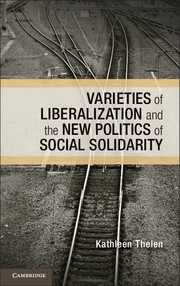Book contents
- Frontmatter
- Dedication
- Contents
- List of Figures
- List of Tables
- List of Abbreviations
- Preface
- 1 Varieties of Liberalization and the New Politics of Social Solidarity
- 2 Industrial Relations Institutions
- 3 Vocational Education and Training
- 4 Labor Market Policy
- 5 Coalitional Realignments and Institutional Change
- 6 The Future of Egalitarian Capitalism, in Light of Its Past
- Appendix A Components of Index and Descriptions of Variables for Figure 1.1
- Appendix B Components of Index for Figures 6.2 and 6.3
- Bibliography
- Index
2 - Industrial Relations Institutions
Published online by Cambridge University Press: 05 June 2014
- Frontmatter
- Dedication
- Contents
- List of Figures
- List of Tables
- List of Abbreviations
- Preface
- 1 Varieties of Liberalization and the New Politics of Social Solidarity
- 2 Industrial Relations Institutions
- 3 Vocational Education and Training
- 4 Labor Market Policy
- 5 Coalitional Realignments and Institutional Change
- 6 The Future of Egalitarian Capitalism, in Light of Its Past
- Appendix A Components of Index and Descriptions of Variables for Figure 1.1
- Appendix B Components of Index for Figures 6.2 and 6.3
- Bibliography
- Index
Summary
We can begin the analysis of divergent trajectories of change with an examination of developments over the past two decades in industrial relations. This is an area in which scholars who are focusing on different measures often reach wildly different conclusions concerning the relative stability of traditional arrangements (see Thelen 2012). VofC scholars expect stability, at least in CMEs. They argue that even though employers in liberal market economies may well seek deregulation, those in CMEs will continue to support traditional arrangements because their competitive strategies rely on a high degree of labor cooperation, wage moderation, and peaceful plant relations – all elements that the institutions and practices associated with coordinated bargaining safeguard and protect.
VofC critics, by contrast, maintain that employers in CMEs are no more supportive of these arrangements – or for that matter of unions – than their counterparts in the Anglo-Saxon world, and in fact seek at all turns to escape from the regulatory constraints imposed on them by organized labor and the state. VofC critics maintain that globalization has tilted the balance of power against labor, emboldening and empowering firms to increase flexibility and lower costs (Kapstein 1996; Katz and Darbishire 1999; Martin and Ross 1999). The direction of change is the same cross-nationally – neoliberalism – and any observed variation in the pace of institutional change is for them a matter of successful labor defense, not divergent employer preferences.
- Type
- Chapter
- Information
- Publisher: Cambridge University PressPrint publication year: 2014

